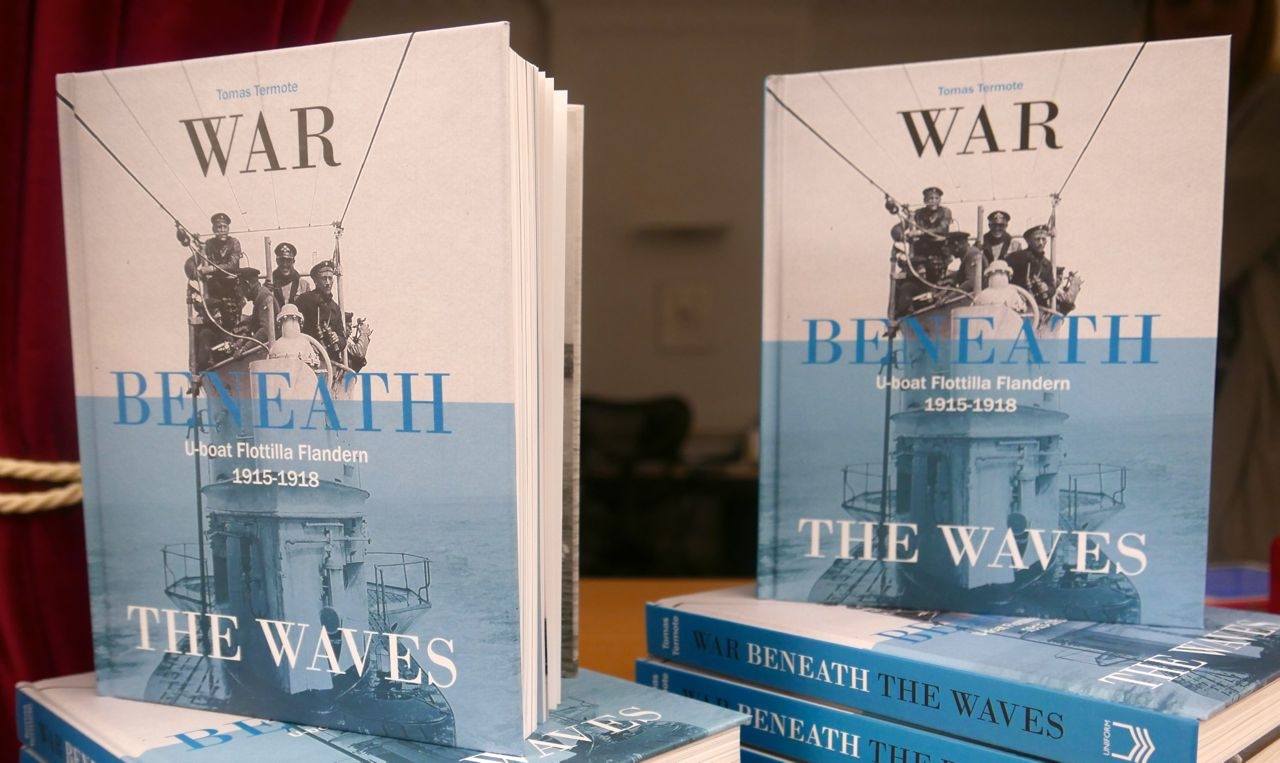German U-boat operations on the Flemish coast were discussed by Belgian marine archaeologist Tomas Termote at a lecture launching the English-language edition of his book on the First World War submarine campaign. CN Editor Peter Alhadeff heard him speak at Flanders House in London.
Think of U-boats and the steely grey of the Atlantic immediately comes to mind. Less so, tranquil canals stretching across the Flemish countryside from picturesque Bruges to the open sea. Yet as Tomas Termote reminds us, Flanders was at the centre of the German submarine campaign which threatened Britain’s maritime lifelines at the height of the Great War.
Bases on the Flemish coast put U-boats much closer to Allied shipping and the cross-channel routes supplying the Western Front. Such was the importance of this battleground that a small submarine was specially built to operate in the sandy shallows of the southern North Sea.
A contemporary German recruitment poster depicts the British Isles surrounded by shoals of U-boats, isolated from the sea lanes on which the UK war effort depended. It’s among a wealth of photos and illustrations amassed by Tomas Termote in the newly-published English edition of his War Beneath the Waves: U-boat Flottilla Flandern 1915-18′. The book provides a welcome insight into the German side of the story for an Anglophone readership.
As Termote puts it, Germany went for Britain’s ‘Achilles heel’, dramatically expanding its submarine fleet from just 28 boats in August 1914.
“Four years later, the Germans would have 330 working U-boats, plus the same amount which were awaiting completion in dockyards in Northern Germany.”
“If the war had lasted, let’s say two or three years longer, the Germans would have had a fleet of nearly 1,000 U-boats.”

Bruges, with its canals to the North Sea at Ostend and Zeebrugge, was chosen as the headquarters for the Flanders U-boat Flotilla. Its concrete shelters bear a striking resemblance to those built on the French Atlantic coast a generation later.
“The Bruges docks were perfect because they lay about 12 kms (7 miles) inland so they were not reachable for (inshore) bombardment. The Germans improved and fortified the pre-war facilities, and proximity to the town was perfect for the officers and the men.”
Often portrayed at best as latter-day buccaneers, and pirates at worst, the U-boat crewmen emerge with a more human face from the encyclopaedic pages of ‘War Beneath the Waves’, although the delights of Bruges may have proved scant reward for the dangers at sea.
Among the most striking images is a picture of four engineers on deck for a breath of fresh air, their eyes squinting in the daylight after the perpetual gloom of the engine-room.
Debilitating
Medical reports reveal a range of debilitating illnesses, both physical and mental, says Termote. Digestive and hearing disorders were commonplace, while many officers suffered nervous breakdowns under the stress of command. Heart problems could also be brought on by prolonged lack of oxygen.
And of course many crewmen were lost in action as Britain’s Royal Navy fought to contain the threat.
In 2018, the centenary will be marked of the Zeebrugge Raid, a daring British attempt to block the harbour at Zeebrugge by sinking blockships on St George’s Day 1918.
Tomas Termote is in no doubt that Flanders was the most successful of Germany’s four European naval bases during the First World War.
“By 1st May 1918, a staggering total of more than 2,500 Allied ships had been sunk, mostly in the North Sea and the Western Approaches by the Flanders Boats.
“On the other side of the coin, 80 per cent of the fleet was lost at sea. 73 U-boats would be sunk, five would be interned. More than 1,200 men would be killed at sea.”
War Beneath the Waves: U-boat Flottilla Flandern 1915-18 is published in English by Uniform Press. There are also Dutch/Flemish and German editions.
Images: Centenary News